Site menu:
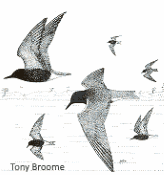
May 2017 Newsletter
Gronant Little Terns.
Colour Ring Report.
April Bird News.
Forthcoming Events.
Latest Newsletter.
Gronant Little Tern Colony - Looking forward to the
2017 Season and a Review of 2016.

2017 Season - Appeal for Volunteers
Gronant is one of the largest Little Tern colonies in the British Isles and consistently one of the most productive - in terms of the number of fledglings it was the second best colony in 2016. None of this could have been achieved without volunteers to help protect the colony, and these have been present since wardening started way back in 1975. But before the birds arrive in 2017 we need to put the electric fences up and with the ever increasing size of the colony this job gets bigger every year. Here are the details if you can help:
Tuesday 2nd May,
Wednesday 3rd May, Thursday 4th May, Friday 5th May.
Meet 10am to spend each day installing the fencing at the Gronant Little Tern
Colony.
VOLUNTEERS NEEDED!
On
Tuesday 2nd May, the hard work begins at Gronant Dunes, near Prestatyn.
There is over a kilometre of electric fencing to construct to protect
one of the largest Little Tern colonies in Britain and Ireland. If you
are available, we are meeting at 10am in the car park opposite the
Crofter’s Cafe on Shore Road, Gronant. This task is impossible to
finish in a day so you can also join us on Wednesday 3rd, Thursday 4th
and Friday 5th May.
For further details ring 01352 810614
or 01745 356197.
Wardening will start in late May and carry on until at least the end of July. It is a very rewarding job and volunteers can more or less choose their own hours. As well as the spectacle of so many Little Terns there are plenty of other birds to be seen, in the sand dunes, on the beach and out to sea. If you wish to volunteer ring 01352 810614 or 01745 356197.
Whether wardening or not Gronant is a fabulous place to visit - see my Gronant Site Guide (click here). Some details of what wardening involves is given here (this was written eight years ago so some info may be out of date): May 2009 Newsletter.
2016 Season
2016 was another record breaking season with a record number of pairs breeding (141) and the largest number of adult Little Terns ever counted on the beach (including birds which didn't breed at Gronant). The high count of breeding pairs actually surprised me as, after four relatively poor years from 2011 to 2014 in terms of fledglings, the normal pattern would have been a drop in numbers and the graph shows how this has happened in the past. So this implies either that birds previously fledged at other colonies are now breeding at Gronant, that numbers of fledglings at Gronant have been under-estimated or that winter survival has been unusually good over the past few years - it may be all three.
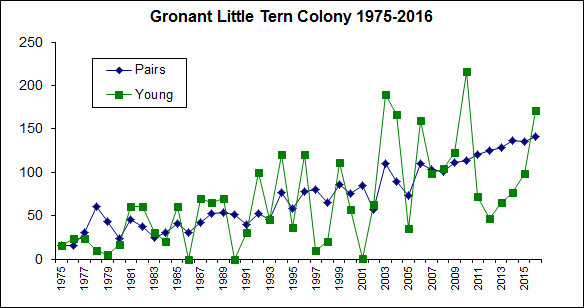
There was no shortage of fledglings in 2016 and they reached an excellent 170, a number only exceeded twice with 190 in 2003 and 216 in 2010. To maintain numbers it is reckoned that productivity (the average number of fledged young per nest) has to be 0.7. For the first time since 2010 the 2015 productivity was above this threshold with 0.73 and 2016 was way beyond this with 1.2. The average productivity at Gronant for the past 10 years, despite those four poor years, is 0.9 so numbers should continue to increase.
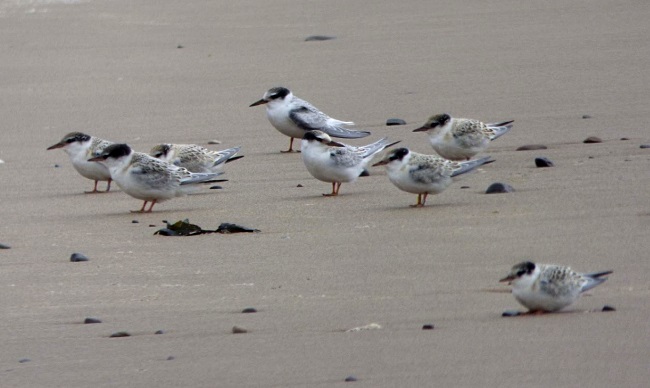
Colour Ringing and The Third Wave
Colour ringing of Little Terns in the
UK and
Ireland only started recently but promises to transform our
knowledge of the movements of Little Terns, about which we know very
little, as well as being able to determine such things as survival
rates. It has already given an insight into where our 'third wave'
comes from, but first I better explain what the third wave is:
Most
years the Gronant Little
Terns seem to arrive in three
waves. The first being the early arrivals around the second week in
May. Some of these may well be passing through on their way further
north, but in any case many disperse to feed up before returning in a
much bigger second wave in late May and early June when they get down
to some
serious nesting. The third wave is more of a puzzle when there is a
sudden increase in the number of adults* during the third week
of July. It seems to happen every year and increases the total
number by between 200 and 300. In 2016 this third wave was
particularly noticeable with a remarkable 650 adults counted on July
21st, easily the highest ever count at Gronant.
In 2016 several colour-ringed birds ringed as chicks in Ireland were recorded at Gronant, including three ringed in 2015 and another in 2014. This is fascinating as it confirms the presence of non-breeding immature birds in the Irish Sea, previously it was thought that first year birds probably spent the summer off West Africa. Other non-breeding birds consist of adults taking a year off from breeding as can happen regularly with this long lived species; this means that among the Irish Sea Little Terns a good proportion consists of non-breeding birds and these may well turn up at Gronant in July, perhaps having spent a leisurely few weeks moving north behind the breeding birds. In addition many Irish Sea colonies had a poor breeding season in 2016 with many adults reported as leaving the colonies early, just when when there was a build up of numbers at Gronant.
All this indicates that Gronant is of particular importance not only as a large breeding colony but also as a migration staging post - presumably because of the abundance of food available.
Another
thing colour-ringing will tell us is how much inter-change between the
colonies there is, and it is quite likely that the Irish Sea birds
consist of a meta-population with some moving between colonies from
year to year. Four colour-ringed birds from Kilcoole in Ireland were
recorded at Gronant in 2016, Kilcoole is just 100 miles due
west
of Gronant and is a major colony so it will be fascinating to see if
birds ringed at Gronant turn up there in future years, as well as the
other way round.
If you see any colour-ringed Little
Terns at Gronant then report them to the wardens present, record both
the letters/numbers and colour of the ring - being so small they are
not easy to read! Away from Gronant report them via the normal channels
(e.g. Euring)
but also to the LIFE Project Manager Susan.Rendell-Read@rspb.org.uk.
In addition I would very much appreciate it if you could send me,
Richard Smith  , details of any
colour ringed birds and I will put it in the the monthly
Ringing Report in this Dee Estuary Newsletter, giving you full credit
as always.
, details of any
colour ringed birds and I will put it in the the monthly
Ringing Report in this Dee Estuary Newsletter, giving you full credit
as always.
*
in this instance 'adult' means all birds which aren't
fledglings/juveniles, so these could include immature first and second
year birds which are very difficult to tell from adults in the field.
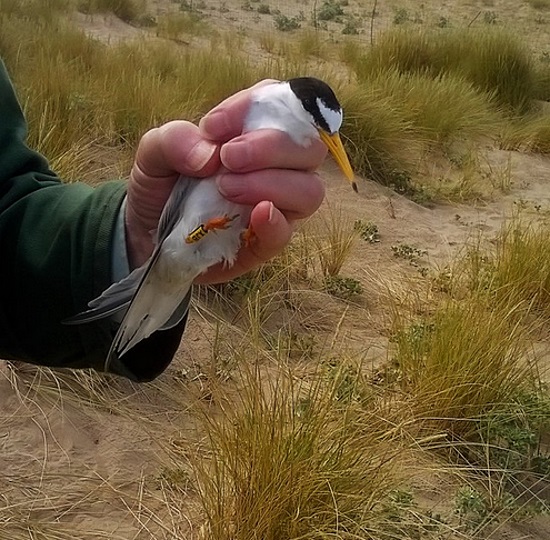
LIFE Little Tern Recovery Project
Although they continue to thrive at
Gronant, nationally Little Terns are struggling and this project was
set up four years ago to help them. One of the main aims is fact
finding and research to try and understand this species better. At the
end of this five year project there will be a Conservation Plan:
"The LIFE Project partners are starting to draft and then will consult on a Conservation Plan for the UK little tern population. The plan will be in place beyond the term of the LIFE Project and will require a step up in local, regional and national advocacy for the protection of little terns and their coastal habitat."
For more information on Little Terns generally, the LIFE
Project and reporting Colour-ringed Little Terns see: www.littleternproject.org.uk/.
Little Terns and Sea Holly by Judith Samuel
For
anybody interested in Gronant and it's Little Terns I can
heartily
recommend this book, it also gives a really good insight into the life
of a voluntary warden. I'll be reviewing this book in detail in my next
newsletter but in the meantime it can be purchased at
http://www.penlanpublishing.com/buy-now/
or at Amazon.co.uk.
Acknowledgements and Further Reading
1. The RSPB initially began the wardening scheme in 1975 without which the colony would not now exist. The graph used above was first drawn by Gareth Stamp of the RSPB and I've updated each year since. The RSPB still help and advise at the site and are also an important partner in the LIFE project.
2. Denbighshire Countryside Services
who now run the wardening scheme and own the land the Little Tern
colony is on - Gronant Dunes SSSI.
See http://www.denbighshirecountryside.org.uk/little-tern-project/
3. North Wales Little Tern Group - https://en-gb.facebook.com/nwlittletern/,
email: nwlittletern@gmail.com.
4. All the wardens, both contract and volunteers, over the many years since 1975.
5. Henry Cook (2016 Warden), who passed on the information about the colour-ringed Little Terns described above.
6. The Gronant Little Tern Report 2016, Denbighshire County Council Countryside Service.
7. Kilcoole Little Tern Conservation Project - littleternconservation.blogspot.co.uk.
8. David Cabot & Ian Nisbet, Terns, New Naturalist Library, Collins, 2013.
Richard Smith
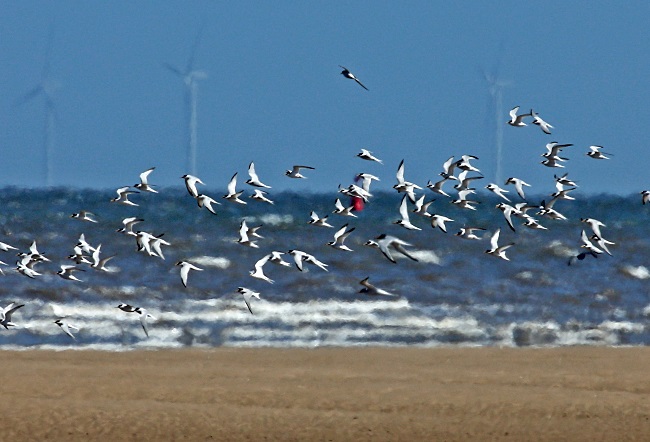
Colour Ring Report
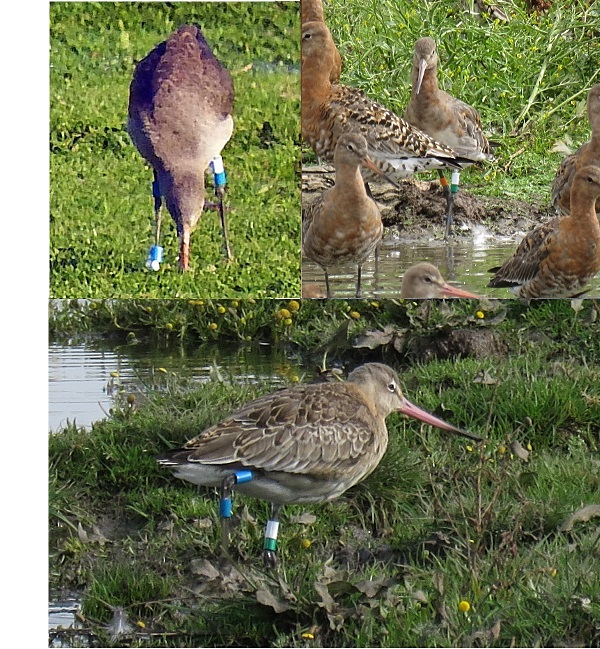
We've recently had some long awaited feedback for several Scottish ringed Black-tailed Godwits and several gulls ringed on the Isle of Man, including our first colour-ringed Lesser Black-backed Gull. So very much a Scottish and Manx special this month!
It was an exceptional April for colour-ringed Black-tailed Godwits which were moving through the area on their way to Iceland - we are still waiting for feedback for many so I will give details in the June Newsletter.
Black-tailed Godwits
Note that all these Scottish ringed Black-tailed Godwits are ringed as juveniles which means that we know exactly how old they are which is extremely useful when calculating survival rates and longevity. They all have a blue ring on the right tarsus which is what //B means.
OL-O//B
- ringed as a juvenile at Montrose Basin, NE Scotland, on September
30th 2007.
Dee estuary records: Seen here in August 2013
on return migration where it was recorded at Gilroy, Caldy Shore and
Inner Marsh Farm, and in September 2013 at Thurstaston Shore.
Elsewhere,
this bird winters in Portugal and migrates back north via the
Netherlands, as many of them seem to do. The only other UK records are
from the Blackwater Estuary, Essex, on return migration in August and
September 2015.
WG-O//B
- ringed as a juvenile at Montrose Basin, NE Scotland, on September
21st 2013.
Dee estuary records: Seen here at Gilroy and Thurstaston in July and
August 2015 and August and September 2016.
Elsewhere,
this bird was recorded in West Sussex in November 2013 and the spring
of 2014. There are no other UK records, it has been recorded twice in
France both in SE Brittany during the winter of 2014/15, so presumably
that is where it winters.
This spring (2017) it was on Tiree on it's way back to Iceland on April
18th.
WG-B//B
- ringed as a juvenile at Meikle Loch, NE Scotland on August 23rd 2015.
Dee
estuary records: In 2015 it was at Gilroy from late September to late
October. The first record in 2016 was at Burton Mere Wetlands in July,
it subsequently turned up at Gilroy and was present from early August
to September and was also recorded at Thurstaston in October and
November. No winter records but it was seen at Caldy in April 2017 in
full breeding plumage.
The only other records were at Bilsborough in Lancashire in March 2016
and at Leighton Moss on April 1st 2017, prior to flying south to Caldy.
WB-B//B
- ringed on the Ythan Estuary NE Scotland on August 12th 2015.
Dee
estuary records: we think this bird may have been at Burton Mere
Wetlands in July 2016 but the first definite record was from Gilroy in
early August 2016 where it stayed until October and then moved to
Thurstaston Shore until the end of January 2017.
Elsewhere, it was
at Bo'ness by the Firth of Forth in September 2015 before moving to the
Ribble Estuary where it was recorded in October 2015 and early January
2016. The only other record was from Dinas Dinlie near Caernarvon (NW
Wales) also in January 2016.
Lesser Black-backed Gull
TOVD
- yellow letters on black ring.
Ringed at the Point of Ayre gravel pits, Isle of Man, on May 24th 2015.
Recorded on Hoylake Shore on October 1st 2016.
Great Black-backed Gulls
T4YK
- yellow on black ring.
Ringed on the Calf of Man, Isle of Man, as a chick on June 24th 2014.
Recorded on Hoylake Shore on July 22nd and 23rd 2016.
T5ZV
- yellow on black ring.
Ringed on Kitterland Island, Isle of Man, on July 22nd 2013.
Recorded on Hoylake Shore on July 3rd 2015 and July 6th 2016.
April Bird News

I'm not sure if this makes sense but
March's early spring turned into a late spring in April thanks to
prolonged northerlies. You can see from the table that all the March
first arrivals were earlier than 2016 whilst, apart from Swifts which
were more or less on schedule, the April arrivals were late.
| Species | 2017 | Location | 2016 | 2015 |
|---|---|---|---|---|
| White Wagtail | 4th March | Hilbre | 15th March | 10th March |
| Sand Martin | 11th March | Hilbre | 16th March | 7th March |
| Wheatear | 11th March | Burton | 23rd March | 11th March |
| Swallow | 14th March | Meols | 24th March | 20th March |
| Willow Warbler | 17th March | Shotton | 29th March | 22nd March |
| House Martin | 27th March | Leasowe Lighthouse |
7th April | 31st March |
| Whitethroat | 17th April |
Shotwick | 13th April | 12th April |
| Swift | 19th April | West Kirby | 22nd April | 19th April |
| Cuckoo | 24th April |
Burton | 21st April | 20th April |
But the wind direction changed to the south-east at the end of the month and what a difference it made. Perhaps the biggest story on the last day of the month was a massive influx of Black Terns into the country and we had our fair share with 17 off East Hoyle Bank, four off Hilbre and five at Connah's Quay. On the same day we also had a Spotted Crake at Red Rocks, over 100 Willow Warblers on Hilbre, at least 10 Whinchats at Leasowe and seven Grasshopper Warblers at Parkgate/Heswall.
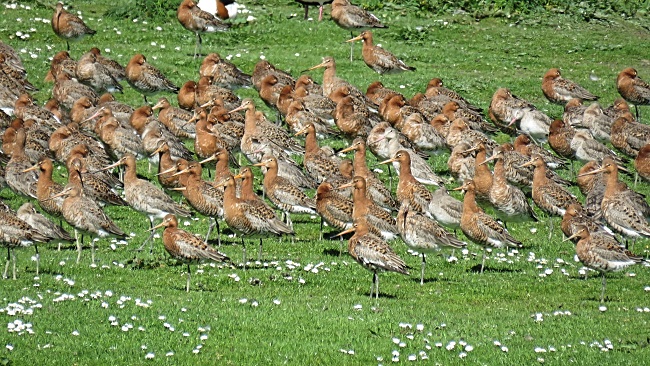
The rest of the month had been relatively quiet but there was some
notable exceptions including several hundred Black-tailed Godwits in
full summer plumage at Burton Mere Wetlands, Caldy and Connah's Quay,
these paused on their way north waiting for the wind to change before
their long flight to Iceland. There were also good numbers of Dunlin
particularly at Hilbre where up to 6,000 were counted and it was a
remarkable sight when they all roosted on top of the island
right in front of the old Lifeboat Station - see the Hilbre Bird Obs Blog entry for April 28th.
There were also good numbers of Whimbrels coming through with 97 on
26th and 84 on 29th being the two highest counts, both at Heswall.
There was a good passage of White Wagtails with at least 34 on Hoylake
Shore for several days early in the month, 37 at Red Rocks on the 8th,
strong winds then seems to have driven the passage further inland and
for several days up to 123 were on ploughed fields between Riverbank
Road and Banks Road, Heswall.
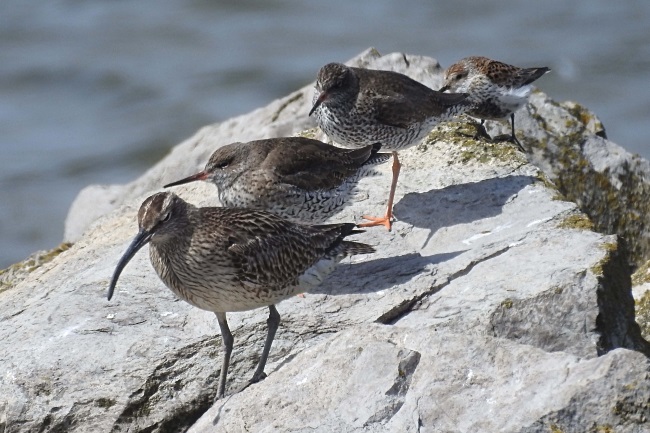
Top of Page
What to expect in May
I love seeing the waders come through in May knowing how far they have travelled and how much further they still have to go. We will get a spring peak of Dunlin and Ringed Plovers, as well as plenty of Whimbrels and Sanderling, the latter are often still passing through right at the end of the month and even into June. We can also see rarer waders at this time of year including Curlew Sandpipers, Little Stints and even Dotterels.
Out to sea will be Gannets and Common Scoters, and given a fresh westerly, skuas and Manx Shearwaters.
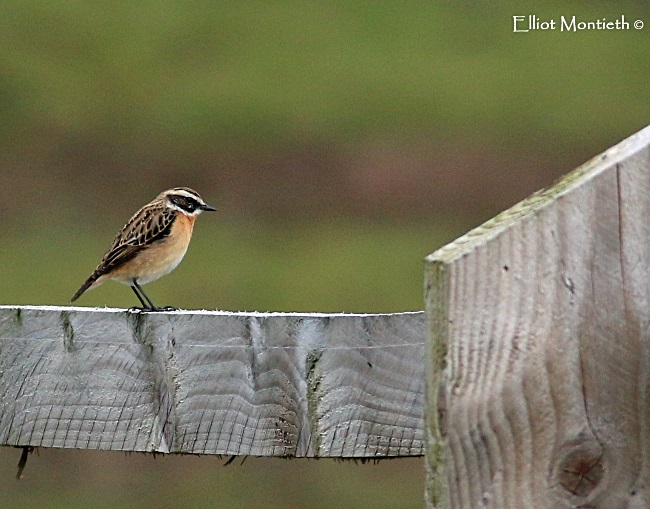
Top of Page
Forthcoming Events
May Highest Spring Tides (Liverpool)
Also
see Tides
page.
25th May, 11.21hrs (BST), 9.7m.
26th May, 12.08hrs (BST), 9.9m.
27th May, 12.57hrs (BST), 9.9m.
28th May, 13.47hrs (BST), 9.7m.
Forthcoming Events
Organised by the Wirral
Ranger Service , Flintshire
Countryside Service and the
RSPB (Dee Estuary):
All these events and walks have bird interest, even those not
advertised specifically for birdwatching. No need to book for these
events unless specified - please check below.
Meet 10am to spend each day installing the fencing at the Gronant Little Tern Colony.
VOLUNTEERS NEEDED!
On Tuesday 2nd May, the hard work begins at Gronant Dunes, near Prestatyn. There is over a kilometre of electric fencing to construct to protect one of the largest Little Tern colonies in Britain and Ireland. If you are available, we are meeting at 10am in the car park opposite the Crofter’s Cafe on Shore Road, Gronant. This task is impossible to finish in a day so you can also join us on Wednesday 3rd, Thursday 4th and Friday 5th May.
For further details ring 01352 810614 or 01745 356197.
Sunday 7th May,
Dawn Chorus at Burton Mere
Wetlands.
5 am-7 am. Price: £6.50 per person (RSPB members £5).
Booking essential.
Ring 0151 353 8478 to book.
It's International Dawn Chorus Day, so join us at Burton Mere Wetlands
to experience the magic of the reserve waking up as the sun rises. With
a wonderful mix of woodland and wetlands, there's no better place to
experience the early morning birdsong.
An expert guide will help identify the bird calls and songs around you,
plus all the other kinds of wildlife that makes its home here. Enjoy a
croissant and a hot drink afterwards in the Reception Hide, then a
chance to explore the rest of the reserve on your own before it opens
at 9 am.
Advanced booking and
payment essential. Price includes the light breakfast
afterwards.
Friday 12th May,
3 reserves, dunes, reed beds and woodland - starting at Gronant.
10am to 2pm,
Booking essential.
ring 01352 810614
to book or email
loggerheads.countrypark@denbighshire.gov.uk.
Explore
sand dunes, reed beds and woodland on this 7 mile circular walk as we
visit three local nature reserves at an exciting time of year with
Denbighshire Countryside Service and the North Wales Wildlife Trust.
Sturdy walking shoes or boots strongly recommended.
Meet at Gronant car park opposite Greenacres Caravan Park on Shore Road.
7 am-10 am. Price: £8 per person, includes cooked breakfast at
Nets Cafe afterwards.
Booking essential.
Ring 0151 353 8478 to book.
Join us for this exclusive event as part of Wirral Walking Festival; a
gentle walk along the Burton Marsh Greenway as far as Burton Point
before retracing our steps to Denhall Lane as far as Nets Cafe for a
full English breakfast.
A variety of warblers are busy establishing breeding territories here
at this time of year, whilst the marsh is peppered with other summer
migrants such as wheatears and alive with the songs of skylarks and
meadow pipits. This early morning walk will offer chance to see and
hear the marsh coming to life for the day in this busy time for nesting
and migrating birds.
The route is along a fully accessible paved track. Booking and payment
in advance essential. Price includes breakfast at Nets Cafe.
Meet at the junction of
Station Road and Denhall Lane, west of Burton village.